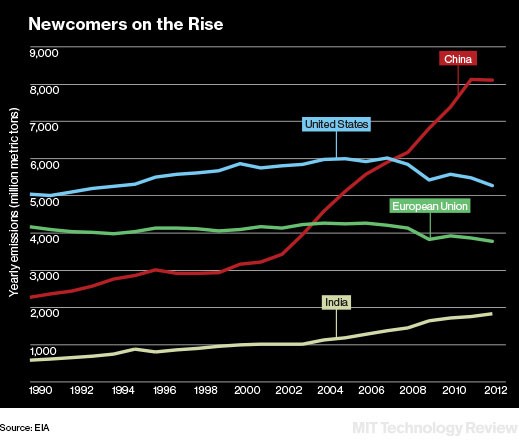The U.S. and Europe Are Mostly to Blame for the Climate Conundrum
A major point of contention during this week’s climate negotiations in Paris is the question of who should be most responsible for the cost of transforming the world’s energy system. And while the need to curb rising emissions from major developing nations is one of the most urgent issues on the table, there is no ignoring the huge amount of heat-trapping gas that richer countries added to the atmosphere well before developing nations began emitting at a high rate.
Fast-growing economies like China, India, Brazil, and Indonesia are now among the world’s biggest yearly emitters and will drive most future emissions growth. But from a cumulative standpoint, wealthier nations are way out in front. That’s important, because the effects of atmospheric carbon dioxide linger for centuries (see “Climate Change: The Moral Choices”), and the long-term climate consequences will hinge on the cumulative amount of carbon dioxide we emit globally.


In its most recent climate assessment report, the Intergovernmental Panel on Climate Change estimated that in order for the world to avoid warming of more than 2 °C, the total amount of carbon emitted since the beginning of the Industrial Revolution must be held to less than a trillion metric tons. The panel also reported that by 2011 we’d already emitted just over half that much. Much of that was due to the United States and wealthy European nations. The chart below shows the cumulative emissions since 1850 for each of today’s top nine yearly emitters (listed left to right).
Keep Reading
Most Popular
Large language models can do jaw-dropping things. But nobody knows exactly why.
And that's a problem. Figuring it out is one of the biggest scientific puzzles of our time and a crucial step towards controlling more powerful future models.
How scientists traced a mysterious covid case back to six toilets
When wastewater surveillance turns into a hunt for a single infected individual, the ethics get tricky.
The problem with plug-in hybrids? Their drivers.
Plug-in hybrids are often sold as a transition to EVs, but new data from Europe shows we’re still underestimating the emissions they produce.
Google DeepMind’s new generative model makes Super Mario–like games from scratch
Genie learns how to control games by watching hours and hours of video. It could help train next-gen robots too.
Stay connected
Get the latest updates from
MIT Technology Review
Discover special offers, top stories, upcoming events, and more.